The NVIDIA GeForce GTX 780 Ti Review
by Ryan Smith on November 7, 2013 9:01 AM ESTHands On With NVIDIA's Shadowplay
Though it’s technically not part of the GeForce GTX 780 Ti launch, before diving into our typical collection of benchmarks we wanted to spend a bit of time looking at NVIDIA’s recently released Shadowplay utility.
Shadowplay was coincidentally enough first announced back at the launch of the GTX 780. Its designed purpose was to offer advanced game recording capabilities beyond what traditional tools like FRAPS could offer by leveraging NVIDIA image capture and video encode hardware. In doing so, Shadowplay would be able to offer similar capabilities with much less overhead, all the while also being able to utilize the NVENC hardware H.264 encoder to encode to space efficient H.264 rather than the bulky uncompressed formats traditional tools offer.
With Shadowplay and NVIDIA’s SHIELD streaming capabilities sharing so much of the underlying technology, the original plan was to launch Shadowplay in beta form shortly after SHIELD launched, however Shadowplay ended up being delayed, ultimately not getting its beta release until last week (October 28th). NVIDIA has never offered a full accounting for the delay, but one of the most significant reasons was because they were unsatisfied with their original video container choice, M2TS. M2TS containers, though industry standard and well suited for this use, have limited compatibility, with Windows Media Player in particular being a thorn in NVIDIA’s side. As such NVIDIA held back Shadowplay in order to convert it over to using MP4 containers, which have a very high compatibility rate at the cost of requiring some additional work on NVIDIA’s part.
In any case with the container issue resolved Shadowplay is finally out in beta, giving us our first chance to try out NVIDIA’s game recording utility. To that end while clearly still a beta and in need of further polishing and some feature refinements, at its most basic level we’ve come away impressed with Shadowplay, with NVIDIA having delivered on all of their earlier core promises for the utility
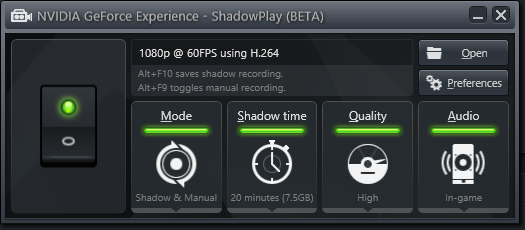
With regards to functionality, all of Shadowplay’s basic functionality is in. The utility offers two recording modes: a manual mode and a shadow mode, the former being self-explanatory while the latter being an always-active rolling buffer of up to 20 minutes that allows saving the buffer after the fact in a DVR-like fashion. Saving the shadow buffer causes the entirety of the buffer to be saved and a new buffer started, while manual mode can be started and stopped as desired.
| Shadowplay Average Bitrates | |||
| High Quality | 52Mbps | ||
| Medium Quality |
23Mbps
|
||
| Low Quality |
16Mbps
|
||
Next to being able to control the size of the shadow buffer, Shadowplay’s other piece of significant flexibility comes through the ability to set the quality (and therefore file size) of the recordings Shadowplay generates. Since Shadowplay uses lossy H.264 the recording bitrates will scale with the quality, with Shadowplay offering 3 quality levels: high (52Mbps), medium (23Mbps), and low (16Mbps). Choosing between the quality levels will depend on the quality needed and what the recording is intended for, due to the large difference in quality and size. High quality is as close as Shadowplay gets to transparent compression, and with its large file sizes is best suited for further processing/transcoding. Otherwise Medium and Low are low enough bitrates that they’re reasonably suitable for distribution as-is, however there is a distinct quality tradeoff in using these modes.
Moving on, at this moment while Shadowplay offers a range of quality settings for recording it only offers a single resolution and framerate: 1080p at 60fps. Neither the frame rate nor the resolution is currently adjustable, so whenever you record and despite the resolution you record from, it will be resized to 1920x1080 and recorded at 60fps. This unfortunately is an aspect-ratio unaware resize too, so even non-16:9 resolutions such as 1920x1200 or 2560x1600 will be resized to 1080p. Consequently at this time this is really the only weak point for Shadowplay; while the NVENC encoder undoubtedly presents some limitations, the inability to record at just a lower resolution or in an aspect ratio compliant manner is something we’d like to see NVIDIA expand upon in the final version of the utility.
Finally, let’s talk about performance. One of Shadowplay’s promises was that the overhead from recording would be very low – after all, it needs to be low enough to make always-on shadow mode viable – and this is another area where the product lives up to NVIDIA’s claims. To be sure there’s still some performance degradation from enabling Shadowplay, about 5% by our numbers, but this is small enough that it should be tolerable. Furthermore Shadowplay doesn’t require capping the framerate like FRAPS does, so it’s possible to use Shadowplay and still maintain framerates over 60fps. Though as to be expected, this will introduce some frame skipping in the captured video, since Shadowplay will have to skip some frames to keep within its framerate limitations.
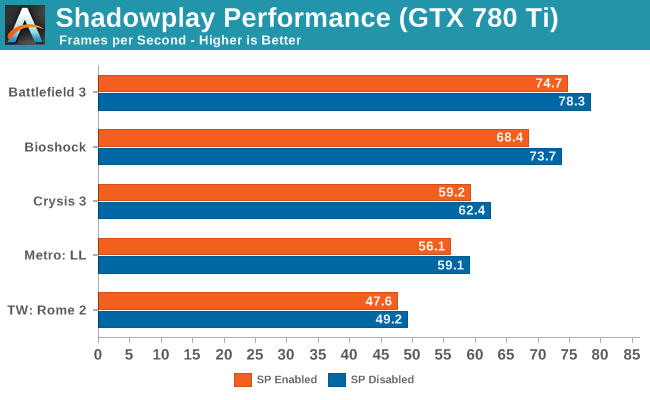
On a related note, we did some digging for a technical answer for why Shadowplay performs as well as it does, and found our answer in an excellent summary of Shadowplay by Alexey Nicolaychuk, the author of RivaTuner and its derivatives (MSI Afterburner and EVGA Precision). As it turns out, although the NVENC video encoder plays a part in that – compressing the resulting video and making the resulting stream much easier to send back to the host and store – that’s only part of the story. The rest of Shadowplay’s low overhead comes from the fact that NVIDIA also has specific hardware and API support for the fast capture of frames built into Kepler GPUs. This functionality was originally intended to facilitate GRID and game streaming, which can also be utilized for game recording (after all, what is game recording but game streaming to a file instead of another client?).
This functionality is exposed as Frame Buffer Capture (NVFBC) and Inband Frame Readback (NVIFR). NVFBC allows Shadowplay to pull finished frames straight out of the frame buffer directly at a low level, as opposed to having to traverse the graphics APIs at a high level. Meanwhile NVIFR does have operate at a slightly higher level to inject itself into the graphics API, but in doing so it gains the flexibility to capture images from render targets as opposed to just frame buffers. Based on what we’re seeing we believe that NVIDIA is using NVFBC for Shadowplay, which would be the lowest overhead option while also explaining why Shadowplay can only capture full screen games and not windowed mode games, as frame buffer capturing is only viable when a game has exclusive control over the frame buffer.
Wrapping things up, it’s clear that NVIDIA still has some polishing they can apply to Shadowplay, and while they aren’t talking about the final release this soon, as a point of reference it took about 4 months for NVIDIA’s SHIELD game streaming component to go from beta to a formal, finished release. In the interim however it’s already in a very usable state, and it should be worth keeping an eye on in the future to see what else NVIDIA does to further improve the utility.
The Test
The press drivers for the launch of the GTX 780 Ti are release 331.70, which other than formally adding support for the new card is otherwise identical to the standing 331.65 drivers.
Meanwhile on a housekeeping note, we want to quickly point out that we’ll be deviating a bit from our normal protocol and including the 290X results for both normal (quiet) and uber modes. Typically we’d only include results from the default mode in articles such as these, but since we need to cover SLI/Crossfire performance and since we didn’t have 290X CF quiet mode results for our initial 290X review, we’re throwing in both so that we can compare the GTX 780 Ti to the 290X CF without being inconsistent by suddenly switching to the lower performance quiet mode numbers. Though with that said, for the purposes of our evaluation we will be focusing almost entirely on the quiet mode numbers, given the vast difference in both performance and noise that comes from using it.
| CPU: | Intel Core i7-4960X @ 4.2GHz |
| Motherboard: | ASRock Fatal1ty X79 Professional |
| Power Supply: | Corsair AX1200i |
| Hard Disk: | Samsung SSD 840 EVO (750GB) |
| Memory: | G.Skill RipjawZ DDR3-1866 4 x 8GB (9-10-9-26) |
| Case: | NZXT Phantom 630 Windowed Edition |
| Monitor: | Asus PQ321 |
| Video Cards: |
AMD Radeon R9 290X AMD Radeon R9 290 XFX Radeon R9 280X Double Dissipation AMD Radeon HD 7990 AMD Radeon HD 7970 NVIDIA GeForce GTX Titan NVIDIA GeForce GTX 780 Ti NVIDIA GeForce GTX 780 NVIDIA GeForce GTX 770 |
| Video Drivers: |
NVIDIA Release 331.58 WHQL NVIDIA Release 331.70 Beta AMD Catalyst 13.11 Beta v1 AMD Catalyst 13.11 Beta v5 AMD Catalyst 13.11 Beta v8 |
| OS: | Windows 8.1 Pro |


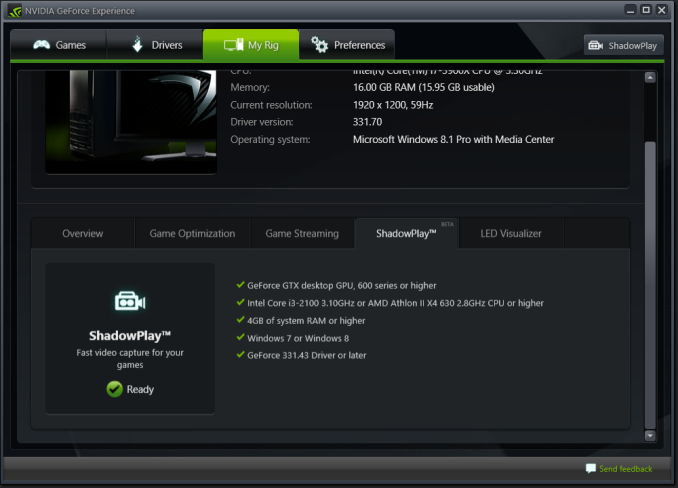
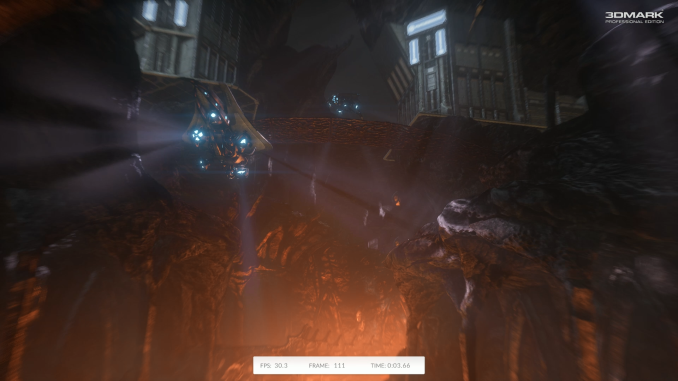

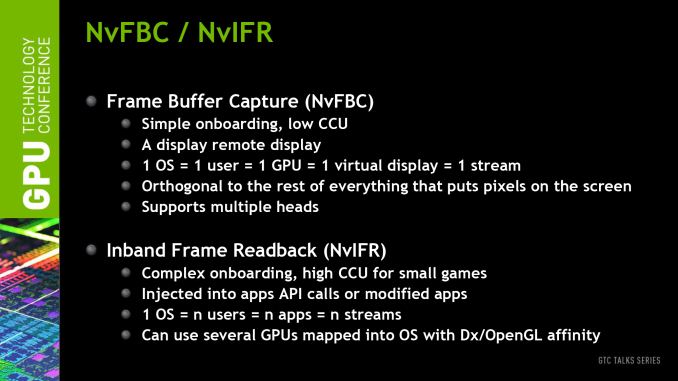














302 Comments
View All Comments
Kamus - Thursday, November 7, 2013 - link
I wouldn't buy that aftermarket cooler just yet.... I was about to buy one when I read that it's not cooling the VRM properly. Some guy bought 2 of them for his crossfire setup and started hearing whine from both cards. He concluded it was the crappy heatsinks that they provide for the VRM aren't up to the task.The VRM was exceeding 100 degrees. This resulted in games crashing and the loud whine I mentioned earlier. In the end, he put the regular AMD heatsinks back on, and that fixed the problem. Then he sold both cards and now he says he might just get regular 290's when they ship with custom coolers. Which isn't a bad idea at all, since those will probably outperform the reference 290x easily, for a lot less cash.
Margalus - Friday, November 8, 2013 - link
so in other words, you have to spend another $100 for an aftermarket cooler to make the 290 a reasonable card?milli - Thursday, November 7, 2013 - link
All you need is an Accelero Xtreme III. It proves that as soon as companies like HIS release better versions, the R9 cards will be silent, fast and cheap. I have a HIS HD 7950, a supposed loud card, that is completely silent.http://www.computerbase.de/artikel/grafikkarten/20...
Sivar - Thursday, November 7, 2013 - link
I gather from the link that you natively speak German. Please note that, in English, "silent" means "absolutely no sound". I think the word you are looking for is "quiet". :)HisDivineOrder - Thursday, November 7, 2013 - link
True, when custom cooled cards come out, that'll be great. None are announced and as far as I know no one's seen any. So you're waving your hands right now and saying, "When better cards come out, they'll be better!"You're talking about unannounced things you expect will come and save the day. I could easily say that overclocked variants of the 780 Ti are going to come and make everything better. Or that the GHZ editions of the 780 (non-Ti) are going to show up and magically make the price point logical again.
But you know what? I'm waiting until what I think MIGHT happen actually DOES happen. Rather than daydreaming about HIS coolers or MSI coolers or Gigabyte Windforce coolers on the R9 series when they haven't shown anyone a sign of such a card yet. Are they coming? Sure, yeah, someday. Are they coming in 2013?
...No one's seen one yet. Hell, there's more evidence of GHZ versions of the standard 780 than there are of custom-cooled R9 290/290x cards...
OverclockedCeleron - Thursday, November 7, 2013 - link
... and your point is? You are happy with a 700-dollar-card, then good for you. I was only speaking up because I have noticed a significant rise of anti-AMD trolls (i.e. Nvidia PR Reps). Just read the first comment to this article and tell me you don't see anything wrong with it.So you like logic and you think you got it all sorted? Well, how about this: Try to judge the silicon and not the fan, i.e., install equally superior GPU air-based coolers, and then Overclock each card to the maximum stable overclock, and re-run the benchmarks. I know who will win, but I am not here to preach or daydream like you said.
The point is, just because I realize the *actual* and *real* potential of something doesn't mean I am a daydreamer, it just means I appreciate that piece of silicon (i.e. R290X) and I realize that it is superior to the 780 Ti if it was not for that cheap heatsink.
TheJian - Thursday, November 7, 2013 - link
You're wrong unless you're saying NV will win after both are equipped with equal cooling and also, Superclocked 780TI has already been announced :)http://videocardz.com/47777/evga-launches-geforce-...
https://www.evga.com/articles/00795/#2884
1006/1072 out of the box. Dual classified has yet to be clocked. But would have to be faster than ACX version and they already have announce the water block model :)
03G-P4-2889-KR GTX 780 Ti Dual Classified w/ EVGA Hydro Copper
Currently you void your warranty pulling this on 290x or 290 right? Sure seems like OEM's have no trouble modding NV. I'm guessing AMD has to sort out this variance stuff before the OEM's can jump on board.
Realizing AMD is getting beaten doesn't make you an NV PR troll...LOL. This doesn't mean AMD's silicon is junk, just it's beaten. I for one am glad they released it forcing NV's full SMX hand. That means we can all look forward to even better 20nm chips as they now have a much higher bar to beat on both sides. I own a radeon 5850 BTW, because I realized it was the best silicon when I bought it (8800GT before that). I go wherever the SILICON/features tells me. The 8800GT is still serving my dad's pc from 2007 (over 6yrs old!). I'm wondering if these 95C chips can make it that long ;) My 5850 will be serving him the second I get my hands on 20nm maxwell (if only for gsync unless NV's chip totally sucks).
Galidou - Thursday, November 7, 2013 - link
No need to be a genius to KNOW that the custom cooled cards will be WORLDS above this even if they are not out. If you did not realise how crappy that cooler is, it was crappy for 7970 cards and it's the sAme... Comon, a little more than 90 IQ is necessary to find out about that...Toxicsix - Thursday, November 7, 2013 - link
More for less you say... Let's look at that. The 290X excels at 4K gaming and that's what AMD keeps cramming down our throat, how superior there product is at the highest resolutions. So If your looking at price performance you need to pair that 290X with a 4K display. Now let's look at some simple numbers shall we. 290X $5-600 + 4K Display $3k+ so your sitting at about $3500+ to get that top end performance. On the other hand you can spend $700 on a 780 Ti and pair it with an amazing 1080p monitor for well under 1k and the 780ti will stop all over Your 290X. Now your probably thinking that this isn't a "fair" comparison but you have to consider that the resolution is where these companies are going to try convince you that there card is superior. As it stands the 780 Ti is the King of 1080p gaming and it pisses me off big time that anadtech didn't even include 1080p benchmarks as this is where the majority of gamers are. If you want the best gameplay possible I would recommend getting the sweetest 1080p monitor you can find that will give you great refresh rates, low input lag and 3D capabilities if that's your thing and pair it with the fastest 1080p gaming card you can find which is now Nvidia's 780Ti. AMD has a great card in the 290X but we can't just look at price/performance based on the card alone we have to consider what were playing it into and look at the complete package as one.Fan_Atic - Thursday, November 7, 2013 - link
I hate to say it but most of your points are completely moot. The reason no one runs 1080p benchmarks in these reviews is that it doesn't stress a modern card. Anything above the $200 price point can pull 60 FPS at max settings any more. No one in their right mind would spend $700 for a graphics card to play at 1080p when a $250 can provide a 60fps experience with the same settings. 1440p 1600p and 4k are the only things that remotely stress modern mid to high end graphics cards.